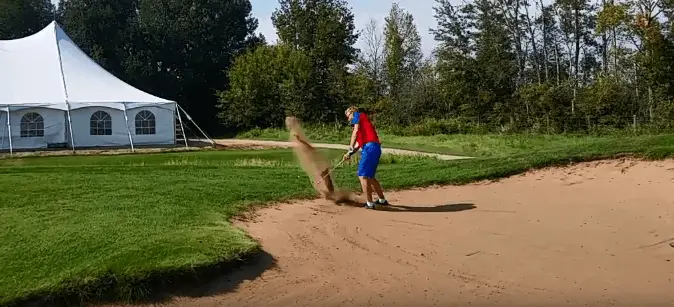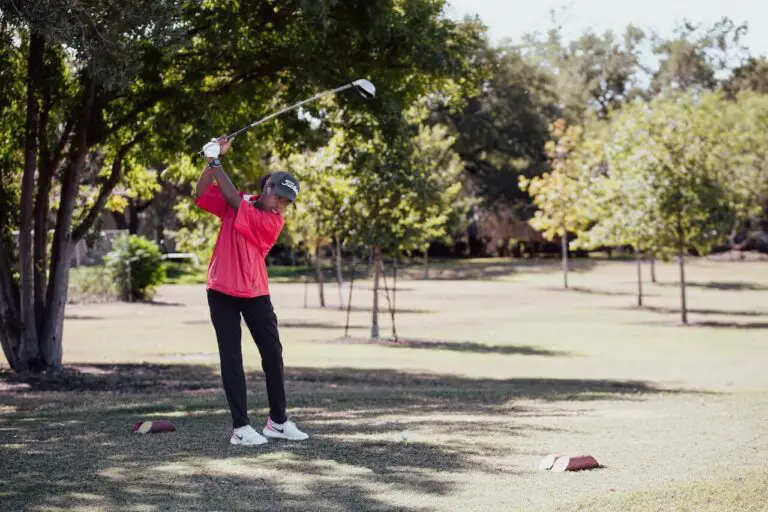Beginner’s Guide to Bunker Shots: Learn How To Hit Bunker Shots

Ah, the bunker shot! It’s that moment in golf where your ball finds itself nestled in the sand, and you might feel a mix of dread and excitement. Whether you’ve seen professionals effortlessly loft the ball out onto the green or you’ve personally experienced the frustration of the ball stubbornly refusing to leave its sandy resting place, the bunker shot is an integral part of golf’s rich tapestry.
What is a bunker shot?
In the world of golf, a bunker is essentially a sand trap designed to present a challenge. These hazards are strategically placed around the golf course, especially near greens, to test a player’s skill and decision-making. A bunker shot refers to any shot played from within this hazard. It’s distinct because unlike other shots in golf where you aim to strike the ball cleanly, in a bunker shot, you’ll often aim to hit the sand first.
Why is it considered challenging for beginners?
For many novices, the bunker can feel like a sandy nemesis. There are a few reasons for this:
- Unfamiliar Terrain: Most of our early golf experiences are on grass, making sand an unfamiliar and unpredictable surface.
- Different Technique: The mechanics of a successful bunker shot can be counterintuitive. The idea of not hitting the ball directly feels odd to many newcomers.
- Mental Hurdle: Let’s face it; there’s a psychological component. When we see sand, there’s an inherent fear of the unknown, especially when we’ve heard or experienced stories of multiple failed attempts.
However, like every challenge in golf (and in life!), with the right guidance and ample practice, you can conquer the bunker and add another feather to your golfing cap. Ready to dive in? Let’s get you out of the sand and closer to the pin!
1. Have The Right Equipment
Before you even think about taking a swing in the sand, let’s talk gear. Just like you wouldn’t use a spoon to cut a steak, using the right club for bunker shots is crucial. It can make the difference between an elegant shot that floats onto the green and a frustrating experience of leaving the ball in the bunker.
Choosing the right sand wedge:
- The importance of bounce and loft:
A sand wedge isn’t just any wedge. It’s specially designed for bunker play. Two key characteristics to consider are its bounce and loft. The bounce is the curve of the sole of the club, which prevents the club from digging too deep into the sand. The loft, on the other hand, helps you elevate the ball and get it airborne. For beginners, a club with a higher bounce and a loft between 54° to 58° is typically recommended. - Different types of sand wedges and their uses:
Not all sand wedges are created equal. There are several types, including:- Standard Sand Wedge (SW): Typically around 56° of loft, this is the classic choice for many bunker shots.
- Lob Wedge (LW): With a loft ranging from 58° to 64°, this can be useful for very short bunker shots where you need the ball to go high quickly but not far.
- Gap Wedge (GW) or Approach Wedge (AW): These have a loft between the pitching wedge and the standard sand wedge, generally around 50° to 54°. They might not be the first choice for deep bunkers but can be handy for longer sand shots.
Remember, while equipment is crucial, it’s only part of the equation. Your technique and confidence play a significant role too. Think of your sand wedge as a trusted companion. Get to know it, practice with it, and soon, you’ll be navigating bunkers with increased finesse and assurance.
2. Set Yourself Up for Success
Okay, so you’ve got the right tool in hand. Now, let’s talk about laying the groundwork, quite literally. Your stance and setup play pivotal roles in executing a successful bunker shot. These foundational elements are akin to the roots of a tree – they ground and stabilize you, allowing for a strong and fluid motion.
Proper stance and ball position:
- Feet alignment and digging in for stability:
Picture yourself at the beach, toes digging into the sand as waves crash nearby. In the bunker, you want to channel that same energy. Start by planting your feet shoulder-width apart and wiggle your feet a little into the sand. This gives you a stable base, lowers your center of gravity, and ensures you’re well-connected to the terrain. It also helps gauge the sand’s depth and consistency. - Ball position relative to your stance:
For most bunker shots, you’ll want the ball to be forward in your stance, roughly in line with your front heel. This position helps promote a steeper swing angle, ensuring you hit the sand behind the ball rather than the ball itself.
Grip and hand position:
- Standard vs. slightly open grip:
Your grip on the club is your connection to the shot. For bunker play, consider a grip that’s slightly more relaxed than your standard grip. This helps promote the necessary wrist hinge in the backswing. Additionally, it can be beneficial to open the clubface slightly, turning it toward the sky, which utilizes the wedge’s loft and bounce to your advantage. - Position of hands relative to the clubface:
Unlike many other shots in golf where you’d have your hands leading (or ahead of) the clubface, for bunker shots, your hands should be more or less in line with the ball. This alignment ensures the club’s bounce is utilized correctly, preventing the club from digging too deep into the sand.
Setting up might seem like a small step, but it’s pivotal. These adjustments not only give you the best chance of a clean, effective shot but also provide a boost of confidence. After all, feeling good and prepared in your setup is half the battle won!
3. The Swing Technique
We’ve talked gear, and we’ve set our stance. Now, it’s showtime: the swing. At first glance, bunker shots might seem like they require some sort of magical touch, but with understanding and practice, you’ll soon realize it’s all about technique and feel.
The backswing:
- Length and height considerations:
A common misconception is that bunker shots require a short, tentative swing. On the contrary, for most sand shots, you’ll want a full and confident backswing, akin to the motion you’d use for a normal pitch shot. This ensures you have enough energy and momentum to move the sand and lift the ball. - Maintaining a relaxed wrist hinge:
As you take the club back, allow your wrists to hinge naturally. This creates the necessary angle for a steep descent into the sand, ensuring you get underneath the ball effectively.
The downswing:
- Focusing on hitting the sand before the ball:
This is the heart of the bunker shot technique. Instead of making direct contact with the ball, aim to strike the sand about an inch or two behind it. Think of it as splashing the sand out onto the green, with the ball riding the wave. - Importance of following through:
Never stop or decelerate your swing upon hitting the sand. A committed follow-through ensures the ball gets the necessary lift and direction. Imagine you’re swinging through the sand and onto the green. - Maintaining a steady head position throughout:
One of the pitfalls beginners often face is the tendency to lift the head too early to see where the ball is going. Maintain a steady head position throughout your swing. Trust your technique, and the results will follow.
Common pitfalls to avoid:
- Decelerating during the swing:
It’s a natural instinct to slow down your swing when nervous or unsure. Resist this urge. A smooth, consistent swing with a confident follow-through is key. - Failing to follow through:
As mentioned, the follow-through is paramount. Think of the sand as a barrier; your goal is to power through it, not to stop at it. - Overthinking the shot:
While technique is crucial, so is intuition and feel. Once you’re set up, trust yourself. Take a deep breath, visualize the shot, and execute.
Remember, bunker shots, like all aspects of golf, require practice and patience. Every bunker is different, every lie unique. Embrace the challenge, learn from each shot, and soon, the bunker will be less of a foe and more of an exciting test of your skills.
4. Gauging the Sand Type
Think of sand not as a singular, monolithic entity, but rather as a diverse terrain, much like the variety of surfaces you encounter elsewhere on the course. Just as you adjust your play for rough versus fairway, understanding the type of sand you’re dealing with can be pivotal for your bunker strategy.
Types of bunker sand and their characteristics:
- Fine Sand:
This is the soft, powdery stuff that feels almost luxurious underfoot. It’s also the type of sand that can be tricky because the club can easily sink into it.- Adjustment Tip: For fine sand, you might not need to hit as far behind the ball as you would in coarser sand. However, ensure you maintain a firm swing to power through.
- Coarse Sand:
Often feels grittier and offers more resistance. Your club is less likely to dig too deep into it, but it can be a bit harder to splash out.- Adjustment Tip: Ensure a full follow-through and focus on utilizing the bounce of your wedge to avoid getting stuck.
- Wet or Packed Sand:
This is often found after a rain or early in the morning when dew is present. The sand becomes compact, and the ball often sits on top, rather than sinking in.- Adjustment Tip: You might need to strike closer to the ball compared to a shot in dry sand. The key is to ensure a crisp contact.
Adjustments to make for wet vs. dry sand:
- Wet Sand:
As mentioned, wet sand can be compact. This might mean a more shallow splash, but with a more aggressive swing, ensuring you can get the ball up and out. - Dry Sand:
In contrast, dry sand is loose and requires a deeper, more assertive swing to ensure the ball is lifted out. Trust your follow-through and imagine displacing a patch of sand onto the green.
The beauty of golf lies in its endless variety, in the myriad situations and terrains it presents. Just as no two golf courses are identical, no two bunkers are the same. As you gain experience and get a feel for different sand types, your ability to adjust and adapt on the fly will grow, turning each bunker encounter into an exciting puzzle to solve.
5. Practice Drills
Rome wasn’t built in a day, and neither is a golfer’s prowess in the bunker. But with consistent practice, those sand traps will start feeling less daunting. Here are some drills tailored to fine-tune your bunker game:
The dollar bill or towel drill:
- Procedure: Place a small towel or imagine a dollar bill’s size patch in the sand. Your goal is to practice entering the sand at the start of the ‘bill’ and exiting at the end, essentially trying to remove the entire ‘bill’ with your wedge.
- Purpose: This helps in visualizing the amount of sand you need to take and where the club should enter and exit the sand relative to the ball.
The splash drill:
- Procedure: Without a ball, focus purely on the sand. Using your bunker technique, aim to splash a consistent patch of sand onto the green with each swing.
- Purpose: It helps develop the feel for how much force is needed to move the sand and ensures you’re using the club’s bounce effectively.
The line drill:
- Procedure: Draw a straight line in the sand. Practice setting up with the line where you’d usually place the ball (an inch or two behind your clubface). Your goal is to strike the sand on the line, ensuring that the line disappears with each swing.
- Purpose: It reinforces the correct point of entry into the sand, ensuring you’re not hitting too far behind or too close to the ball.
Tips for practicing at home and on the course:
- At Home: If you have a sandbox or a similar setup, it’s a goldmine. But even if you don’t, practicing the motion of your bunker swing in your backyard or living room can be beneficial. Focus on the wrist hinge and follow-through.
- On the Course: Whenever you get a chance, spend some extra time in the practice bunker. Vary your shots – try different lies, different sand conditions, and different distances. The more scenarios you encounter, the better prepared you’ll be during actual rounds.
Progress in the bunker, as with all areas of golf, comes down to a mix of proper technique, practice, and mindset. Remember, every golfer, even the pros, had to learn how to master the sand. With dedication and these drills, you’ll find yourself celebrating great bunker shots in no time!
6. Mental Approach and Overcoming Bunker Anxiety
Let’s address the elephant in the room: bunker anxiety. It’s that sinking feeling (pun intended!) you get when your ball lands in the sand. While technique and practice are essential, your mindset can often be the deciding factor in your bunker game.
Understanding the roots of bunker anxiety:
- Fear of the unknown: Especially for beginners, bunkers can seem like uncharted territory, different from the well-trodden fairways and greens.
- Past failures: If you’ve struggled in the sand before, those memories can loom large, causing you to doubt your capabilities.
- Pressure: Feeling the eyes of fellow golfers or the pressure of maintaining a good round can amplify the anxiety.
Strategies to cultivate a positive mindset:
- Embrace the challenge: Instead of dreading the bunker, view it as an opportunity to showcase your skills and improve. Golf is about overcoming obstacles, and the bunker is just one of them.
- Visualize success: Before taking the shot, close your eyes for a moment and imagine the ball landing smoothly on the green. Visualization can be a powerful tool in sports, helping to cement positive outcomes in your mind.
- Stay present: Focus on the shot at hand, not the last bunker mishap or the next hole. Grounding techniques, like feeling the sand beneath your feet or taking deep breaths, can help bring you back to the moment.
- Routine is your friend: Develop a pre-shot routine for bunkers, just as you might for putting or driving. This consistency can be a calming influence, giving you a sense of control.
- Learn and move on: If a shot doesn’t go as planned, take a moment to analyze what went wrong, but don’t dwell on it. Every shot is a learning opportunity. The best players are those who don’t let one bad shot define their game.
⛳ Bonus tip – Practice under pressure:
During your practice sessions, simulate pressure situations. This can be as simple as setting challenges for yourself or practicing with friends where you create mini-competitions. The more you expose yourself to pressure in practice, the better you’ll handle it during actual rounds.
The mind is a golfer’s most potent tool. By cultivating a positive, resilient mindset, you’ll not only improve your bunker game but also enjoy the entire golfing experience more deeply.
7. Advanced Bunker Techniques
As you grow more comfortable in the sand and develop a solid foundational technique, it’s time to explore advanced bunker strategies. These can help you navigate more complex scenarios, turning potential pitfalls into showcases of skill.
Fried Egg Lies:
- Description: This occurs when the ball is partially buried in the sand, resembling a fried egg.
- Technique: Square the clubface (instead of opening it) to allow the leading edge to dig into the sand. Play the ball back in your stance, with a slightly steeper swing to ensure you get beneath the ball.
Uphill & Downhill Lies:
- Uphill:
- Technique: Lean into the slope with your shoulders parallel to the incline. Play the ball forward in your stance and swing along the slope’s angle.
- Downhill:
- Technique: Similarly, match your shoulders to the downhill slope. Play the ball back in your stance and maintain a smooth follow-through.
Long Bunker Shots:
- Description: When the pin is far from the bunker, requiring more distance than a standard bunker shot.
- Technique: Consider using a less-lofted club like a pitching or gap wedge. While the fundamentals remain the same, focus on a shallower entry into the sand, ensuring more ball contact and less sand displacement.
Bunkers with High Lips:
- Description: Some bunkers have tall, imposing faces that can intimidate players.
- Technique: Ensure you have a club with enough loft (like a 60-degree wedge). Prioritize getting the ball high quickly. Remember, it’s okay if you don’t get maximum distance; clearing the lip is the primary goal.
Plugged Lies Against the Bunker Face:
- Description: A challenging scenario where the ball is embedded in the bunker’s face.
- Technique: Play with an open stance and clubface. Swing hard and aim to explode the sand around the ball. It’s tough to get distance in this scenario; focus primarily on getting the ball out.
Reading the Bunker’s Grain:
- Description: In some regions, especially on Bermuda grass courses, the grain of the grass can influence the bunker’s sand texture.
- Technique: Notice the direction in which the grass is growing around the bunker’s edge. Sand will often be firmer when hitting against the grain and softer when hitting with it. Adjust your strike depth accordingly.
Mastering these advanced techniques will take time, practice, and, importantly, real-game experience. As you encounter these challenges on the course, embrace them as opportunities to refine these techniques and grow as a golfer.
8. Bunker Etiquette and Care
Ah, the unsung hero of great golf experiences: etiquette. Beyond the skill and mental game, knowing how to conduct oneself in the bunker ensures that the course remains pristine for everyone. Plus, it’s just good sportsmanship.
Before the Shot:
- Enter Quietly: Always enter the bunker from the lowest side to minimize potential disruption and avoid walking on the steeper faces.
- Club Selection: Keep a couple of club options with you when you go to assess your shot. This prevents walking back and forth, preserving the bunker’s condition.
- Be Mindful of Others: Remember that bunkers can amplify sound. Keep chatter low if other players are taking their shots nearby.
After the Shot:
- Rake Properly: Always rake the bunker after your shot to smooth out footprints and divots. Use a pull/push motion, ensuring you don’t dig the rake too deep, and try to leave a consistent surface for the next player.
- Place the Rake: There are varied opinions on this, but generally, follow the course’s local rule. Some prefer rakes inside the bunker; others outside. If in doubt, place the rake outside the bunker, parallel to the hole’s direction.
- Exit Strategically: Similar to entry, always exit from the lowest point to minimize disturbance.
General Care Tips:
- Practice with Care: If you’re practicing in a bunker on a practice range, always ensure you leave it in as good (or better) condition than when you entered.
- Stay Alert: Pay attention to local rules regarding bunkers. Some courses may have ground under repair within bunkers, and these areas should be avoided.
- Educate Fellow Players: In a gentle and non-confrontational manner, educate newer players about bunker etiquette if they seem unaware. A shared understanding benefits everyone.
Bunker etiquette is, at its core, about respect — respect for the course, respect for fellow players, and respect for the game itself. By upholding these practices, you contribute to the great tradition of golf, ensuring that every player gets a fair and enjoyable experience.
9. Common Bunker Shot Mistakes and How to Correct Them
Every golfer, from beginners to seasoned players, will occasionally face challenges in the bunker. Recognizing common pitfalls and understanding how to correct them can swiftly turn those missteps into learning opportunities.
1. Hitting Too Far Behind the Ball:
- Issue: The club contacts the sand too far behind the ball, causing the ball to either stay in the bunker or move only a short distance.
- Solution: Focus on your visualization techniques. Remember the “dollar bill” analogy and try to strike the sand just 1-2 inches behind the ball.
2. Hitting the Ball First:
- Issue: Instead of splashing the sand, you hit the ball directly, causing it to rocket over the green.
- Solution: Adjust your setup to ensure the ball is forward in your stance. Remember to swing under the ball, allowing the sand to lift it out.
3. Not Using Enough Force:
- Issue: You decelerate the club during the swing, resulting in a weak shot that doesn’t escape the bunker.
- Solution: Trust your swing. Focus on maintaining a consistent speed throughout and ensuring a full follow-through.
4. Over-Swinging:
- Issue: Putting too much power into the swing, leading the ball to fly well past the intended target.
- Solution: Practice controlling your backswing. It doesn’t need to be as long as when you’re on the fairway. Remember, it’s about technique and not power.
5. Not Opening the Clubface:
- Issue: The clubface remains square or shut, making it difficult to get the ball high and soft out of the sand.
- Solution: At setup, ensure your clubface is open. Trust the loft of the club to do the job, and remember to swing through the sand.
6. Poor Ball Position:
- Issue: The ball is positioned too far back or too far forward in your stance, leading to inconsistent strikes.
- Solution: As a general rule, position the ball slightly forward in your stance. Adjust based on specific bunker shot scenarios.
7. Avoiding the Sand Altogether:
- Issue: A fear of hitting the sand causes players to try and scoop the ball out, often leading to mishits.
- Solution: Embrace the sand. The idea is to use the sand to lift the ball, so commit to making a sandy divot.
⛳ Bonus Tip – Self-Diagnosis:
Every time you face a challenging shot or feel something is off with your bunker technique, take a moment to analyze the result. What felt different? How was your stance? Your grip? By diagnosing and addressing issues in real-time, you not only correct mistakes but reinforce proper technique.
Remember, mistakes are a natural part of growth. The key is to approach them with a learner’s mindset, making them stepping stones towards your mastery in bunker play.
10. Equipment Tips for Bunker Shots
While skill and technique are paramount in bunker play, having the right equipment can significantly enhance your game. Here’s a breakdown of essential equipment tips tailored for sand shots:
1. Selecting the Right Wedge:
- Loft: Higher lofted wedges (56 to 60 degrees) are typically used for bunker shots. They help in popping the ball up quickly, especially from deep bunkers.
- Bounce: Bounce is the angle between the leading edge and the lowest point of the club’s sole. Higher bounce wedges (10-14 degrees) are better suited for soft sand, while low bounce wedges are more versatile in firmer conditions.
- Sole Grind: This refers to how the sole, or the bottom of the club, is shaped. Some grinds are crafted to offer more versatility in opening the clubface, which is beneficial in bunkers.
2. Grip Check:
- Worn Out Grips: Ensure your grip isn’t too worn out. In sandy conditions, a good golf grip can make a world of difference in controlling your shots.
- Grip Type: Some golfers prefer corded grips or grips with enhanced textures, especially when playing in moist conditions, as they offer better traction.
3. Practice Balls for Bunker Training:
- Sand-Specific Balls: While there aren’t “bunker-specific” balls, using softer practice balls can help you get a feel for the shot without the risk of damage or injury in confined practice areas.
- Visual Feedback: Consider using impact tape or spray on your clubface during practice. It provides visual feedback on where the ball is making contact, helping you adjust your technique.
4. Rakes and Bunker Tools:
While most golf courses provide rakes, if you’re practicing in a personal sand area:
- Get a quality rake that can mimic the conditions of the course you play on.
- Training Aids: Consider tools like “Bunker Buddies” or training circles. These tools help you visualize and create consistent landing spots in the sand, aiding in the practice.
5. Shoes and Footwear:
- Stability is Key: buy golf shoes that provide solid stability. In the shifting sands of a bunker, a stable footing can make a significant difference.
- Spike Type: Soft spikes or spikeless shoes are preferable, as they disturb the sand less than traditional metal spikes.
⛳ Final Thought: While equipment can assist, remember it’s the archer, not just the arrow. Regular practice and refinement of technique are what will transform your bunker game. However, having gear that complements your style and provides confidence can certainly give you an edge.
Conclusion: Mastering the Art of Bunker Play
The bunker, often perceived as a golfer’s nemesis, can instead become an opportunity with the right mindset and technique. By understanding the fundamentals, adjusting your approach based on the unique challenges each sand trap presents, and dedicating time to intentional practice, bunker play becomes less intimidating and more a part of the holistic golfing experience.
Golf, in its essence, is a game of adaptability and growth. Every sand trap, every challenge, is an invitation to improve, to learn, and to showcase skill. Embrace the journey of mastering bunker shots, and with time, patience, and practice, the bunker will cease to be a barrier and instead become a testament to your dedication and prowess.







Leave feedback about this
You must be logged in to post a comment.